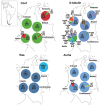Genetic diversity of Phytophthora infestans in the Northern Andean region
- PMID: 21303555
- PMCID: PMC3046917
- DOI: 10.1186/1471-2156-12-23
Genetic diversity of Phytophthora infestans in the Northern Andean region
Abstract
Background: Phytophthora infestans (Mont.) de Bary, the causal agent of potato late blight, is responsible for tremendous crop losses worldwide. Countries in the northern part of the Andes dedicate a large proportion of the highlands to the production of potato, and more recently, solanaceous fruits such as cape gooseberry (Physalis peruviana) and tree tomato (Solanum betaceum), all of which are hosts of this oomycete. In the Andean region, P. infestans populations have been well characterized in Ecuador and Peru, but are poorly understood in Colombia and Venezuela. To understand the P. infestans population structure in the Northern part of the Andes, four nuclear regions (ITS, Ras, β-tubulin and Avr3a) and one mitochondrial (Cox1) region were analyzed in isolates of P. infestans sampled from different hosts in Colombia and Venezuela.
Results: Low genetic diversity was found within this sample of P. infestans isolates from crops within several regions of Colombia and Venezuela, revealing the presence of clonal populations of the pathogen in this region. We detected low frequency heterozygotes, and their distribution patterns might be a consequence of a high migration rate among populations with poor effective gene flow. Consistent genetic differentiation exists among isolates from different regions.
Conclusions: The results here suggest that in the Northern Andean region P. infestans is a clonal population with some within-clone variation. P. infestans populations in Venezuela reflect historic isolation that is being reinforced by a recent self-sufficiency of potato seeds. In summary, the P. infestans population is mainly shaped by migration and probably by the appearance of variants of key effectors such as Avr3a.
Figures



Similar articles
-
Characterization of Phytophthora infestans populations in Colombia: first report of the A2 mating type.Phytopathology. 2009 Jan;99(1):82-8. doi: 10.1094/PHYTO-99-1-0082. Phytopathology. 2009. PMID: 19055438
-
Physiological and molecular characterization of Phytophthora infestans isolates from the Central Colombian Andean Region.Rev Iberoam Micol. 2013 Apr-Jun;30(2):81-7. doi: 10.1016/j.riam.2012.09.005. Epub 2012 Oct 2. Rev Iberoam Micol. 2013. PMID: 23036748
-
First Report of Late Blight Caused by Phytophthora infestans on Cape Gooseberry (Physalis peruviana) in Colombia.Plant Dis. 2007 Apr;91(4):464. doi: 10.1094/PDIS-91-4-0464B. Plant Dis. 2007. PMID: 30781206
-
How Does Phytophthora infestans Evade Control Efforts? Modern Insight Into the Late Blight Disease.Phytopathology. 2018 Aug;108(8):916-924. doi: 10.1094/PHYTO-04-18-0130-IA. Epub 2018 Jul 6. Phytopathology. 2018. PMID: 29979126 Review.
-
Late blight resistance genes in potato breeding.Planta. 2022 May 16;255(6):127. doi: 10.1007/s00425-022-03910-6. Planta. 2022. PMID: 35576021 Free PMC article. Review.
Cited by
-
Genomic Characterization of a South American Phytophthora Hybrid Mandates Reassessment of the Geographic Origins of Phytophthora infestans.Mol Biol Evol. 2016 Feb;33(2):478-91. doi: 10.1093/molbev/msv241. Epub 2015 Nov 17. Mol Biol Evol. 2016. PMID: 26576850 Free PMC article.
-
The Gene Flow Direction of Geographically Distinct Phytophthora infestans Populations in China Corresponds With the Route of Seed Potato Exchange.Front Microbiol. 2020 May 26;11:1077. doi: 10.3389/fmicb.2020.01077. eCollection 2020. Front Microbiol. 2020. PMID: 32528452 Free PMC article.
-
Historic Late Blight Outbreaks Caused by a Widespread Dominant Lineage of Phytophthora infestans (Mont.) de Bary.PLoS One. 2016 Dec 28;11(12):e0168381. doi: 10.1371/journal.pone.0168381. eCollection 2016. PLoS One. 2016. PMID: 28030580 Free PMC article.
-
Mutations in the signal peptide of effector gene Pi04314 contribute to the adaptive evolution of the Phytophthora infestans.BMC Ecol Evol. 2025 Mar 14;25(1):21. doi: 10.1186/s12862-025-02360-4. BMC Ecol Evol. 2025. PMID: 40082776 Free PMC article.
-
Evidence for intragenic recombination and selective sweep in an effector gene of Phytophthora infestans.Evol Appl. 2018 May 9;11(8):1342-1353. doi: 10.1111/eva.12629. eCollection 2018 Sep. Evol Appl. 2018. PMID: 30151044 Free PMC article.
References
-
- Erwin DC, Ribeiro OK. Phytophthora diseases worldwide. American Phytopathological Society (APS Press); 1996.
Publication types
MeSH terms
Substances
LinkOut - more resources
Full Text Sources

